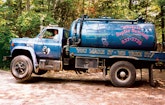Interested in Pumps?
Get Pumps articles, news and videos right in your inbox! Sign up now.
Pumps + Get AlertsDelighting people with the best firework displays they have ever seen keeps Joel White dreaming about what to do next when he isn't pumping septic tanks through his business, White's Septic Service in Dalton, N.H.
He pursued his explosive hobby by setting off smaller Class C fireworks for customers who owned campgrounds, resorts, restaurants and golf courses.
"I talked one owner into letting me put on a show if he paid for the fireworks," says White, 54, who always wears a shirt advertising his pumping company at events. When it got around that the experience had taken his guests to the next level of entertainment, the idea took off like a chain reaction. Nobody wanted to be left out.
As his clientele and their discretionary income expanded, White moved into Class B fireworks, the larger type typically fired off in municipal Fourth of July displays. His brother, Lauren, helped with the grand finale display by welding numerous launch tubes to a trailer. "Light one fuse and it burns through all the tubes," says White. "Standing there as the shots hammer out is incredible."
White uses a cart with three 3-inch and three 4-inch tubes 6 inches apart for single-shot displays. When loaded, 3-foot-long fuses hang over the tops of the tubes. The first 6 inches of fuse are slow burning.
"I use a BernzOmatic Pistol Panther — a belt-mounted propane cylinder with trigger-start hose torch — to light the fuses," says White. "It takes three seconds for the flame to reach the brown paper bag wrapped around the fuse and shot, then ignition is instantaneous."
White has two helpers, one to remove the remains of the burning bag with long iron tongs and one to open and close the locker as White grabs a shot and loads the next tube. "The system makes fireworks safe," he says. "We've never had a problem in 34 years."
Between displays, White stores his fireworks in three steel explosive magazines lined with 4 inches of hardwood. Each door has two locks with quarter-inch steel hoods to prevent sawing and prying. The largest building is 6- by 6-feet.
Helpful friends
White's biggest fireworks displays happen at Santa's Village in Jefferson and at the White Mountain Boogie N' Blues Festival in Thornton. "I belong to the New Hampshire Pyrotechnics Association, as do enthusiasts from Massachusetts," he says. "Their law forbids Class C fireworks, so I invite my friends to blast them off at this festival. When they're done, I set off the big stuff."
Aside from what are considered traditional fireworks venues for his sideline business, White has added a few twists. When his grandmother passed away, White had an inspiration.
"She always liked fireworks, so after the preacher finished the graveside service, I set off a cake of 25 booms," he says. The boom funeral caught on and White lost track of how many he did. He buys the loudest boomers available for the best sound ricochet off the mountains. This somber service soon morphed into a more joyous family event, the boom wedding. While brides throw bouquets, exploding rounds eject parachutes for children to play with after they land.
Three years ago, White added perhaps the most unusual blastoff of his career. When 92-year-old Agnes Mooney requested in her will that he blow up her ashes after she died, he was happy to oblige.
"Cremated remains average about 5 pounds, so I tested a 4-inch Class B boom to see if it was powerful enough to achieve the required altitude," says White. He filled a large, empty baked beans can with gravel, dirt and rocks, sealed it, and glued it to the top of the shell. The test was successful.
As part of the family's celebration of life, White fulfilled Mooney's last wish by sealing her ashes in another baked bean can, gluing it to a 4-inch Class B boom, and igniting the fuse. "The explosion blew her ashes out of the can and into a perfect ball," he says. "They stayed round for a long time as they drifted down over the shooting range she enjoyed so much in later life. I couldn't believe how neat it was."
Pumper ingenuity
Ronald White started the company in 1963, then had seven heart attacks in 1972. "I was the only one still at home out of six kids who knew the job and could hop in the truck and support the family," Joel White says. He was 14.
But the state licensed drivers at age 18. "The police knew our situation and they let me go," he says. "I drove all over Vermont, up to the Canadian border, down below the Crawford and Franconia Notches, and over to the Maine border with no license." He bought the business in 1973.
White's determination and innovative nature also extends to his truck. In 1982, he custom-ordered a GMC 7000 Series chassis and set it up for stunt driving to assist him on the steep mountain roads. "I can whip the truck around on tar or dirt for a better approach to a road I want to take, or go sideways to line up with the road or a parking space," he says. "In winter, if I can't make it up the mountain to service a customer, I can slide the truck around and drive back down."
White has changed out the engine eight times and will do so again this winter. "I can't buy a bigger vehicle because it wouldn't fit into tight places, and that's all we have in the White Mountains," he says. "My truck allows me to back up close to the tank and pump faster with a lot less work." He prefers 260 air-cooled Jurop vacuum pumps.
In 1992, White replaced the secondhand 1,500-gallon steel tank he mounted on the chassis with a 2,100-gallon steel tank. White will replace it this winter with a 2,100-gallon stainless steel tank ordered from TEAMCO in Warwick, Quebec, Canada, through Desrochers Farm Equipment in Derby, Vt.
Harnessing the wind
His wife, Bonnie, runs the office. Because mountains interfere with cellphone signals, White built an FM radio tower on Dalton Mountain, enabling Bonnie to reach him over a 50-mile service radius. "I bought my own radio station number to avoid needing a repeater system to get long range," he says.
At an elevation of 1,900 feet, the wind blows constantly out of the west at White's home. He put it to work after purchasing and repairing a toppled and broken 20-foot-diameter, five-blade wind turbine. White mounted the machine to the tower's 10- by-10-foot octagon platform.
"The 19 kW generator will produce enough electricity for all our needs," he says. "I'll tie into the grid, and the local utility will pay me 18.5 cents per kilowatt hour in credits."
The company's 50th anniversary is 2013, but White views it as just another year in the life of a pumper. "Every day is a party with us," he says. "We're a big family and always doing something." Whatever it is, it will involve fireworks.









